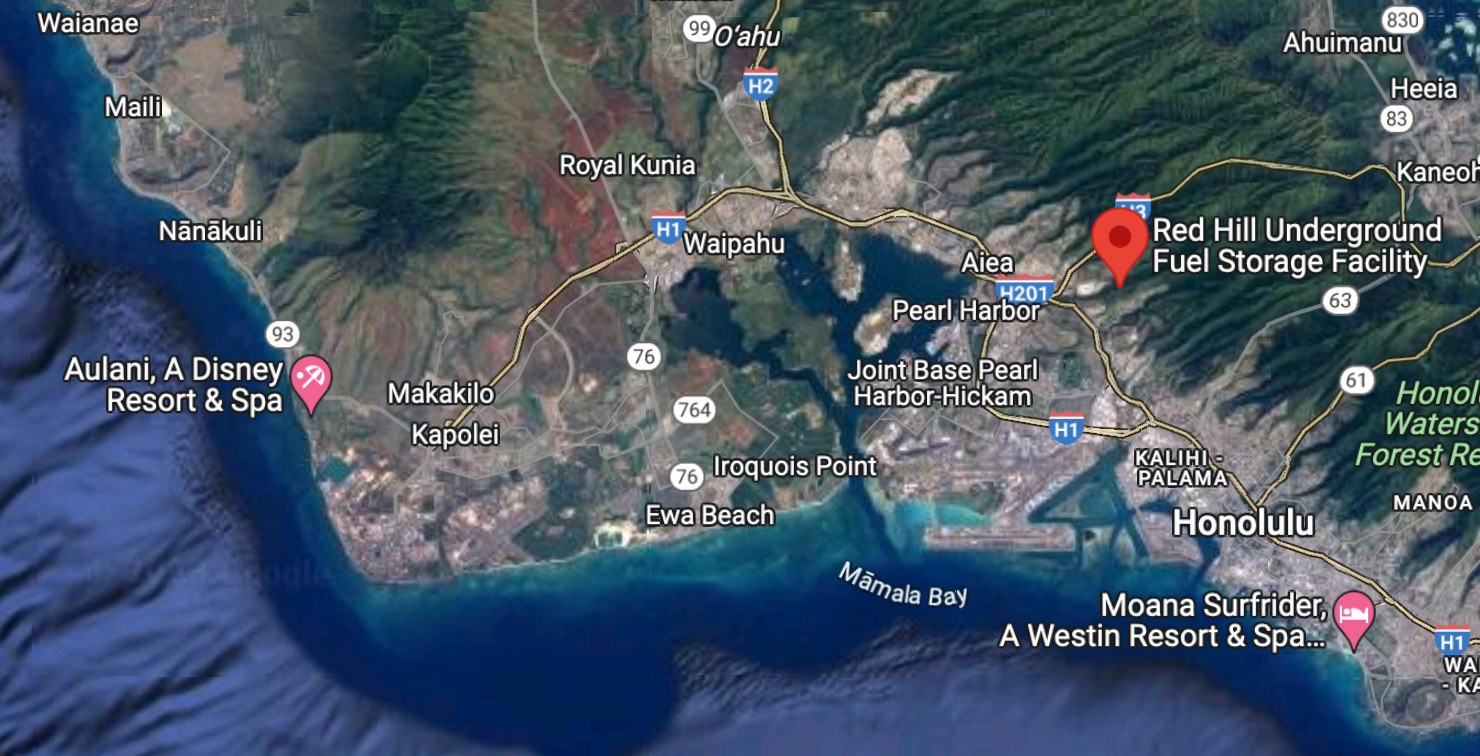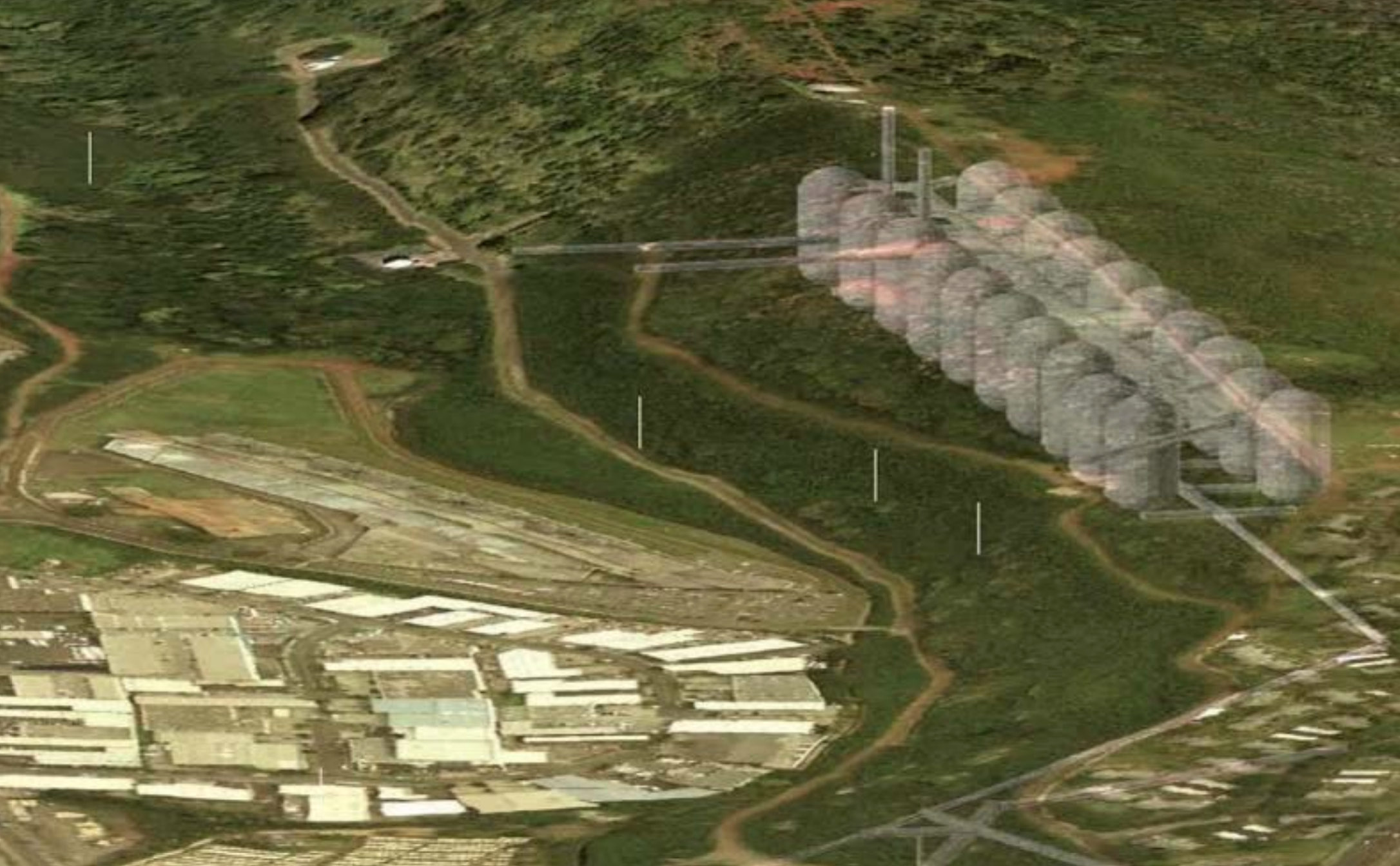Sign up for daily news updates from CleanTechnica on email. Or follow us on Google News!
Back in World War II, the American military had a problem, the same one the Russians are facing today. It needed absurd amounts of fuel for its military efforts, and aboveground tanks were huge, stationary, thin-skinned targets full of flammable material. So the US military started digging underground caverns for its fuel supplies near bases where it could and using gravity to run the fuel down to the base.
In 1940, the US government was looking at the winds of war and looked at the fuel tanks at Pearl Harbor and said to itself, that’s a strategic weakness. After all, a lot of the Pacific Fleet was operated out of the Harbor, and if they couldn’t put fuel in the ships and planes, then they had a lot of expensive steel, not a military force. So they surveyed the nearby hills and settled on a site 2.5 miles (4 km) from the harbor. It became the Red Hill Underground Fuel Storage facility.

Site of Red Hill Underground Fuel Storage in O’ahu courtesy Google Maps
They applied some innovative construction techniques including vertical tanks and expanding shafts with rock conveyors at the bottom that enabled them to build the facility much more quickly than historical techniques. It wasn’t in time for them to be complete for the Japanese attack in 1941, however. The construction area became the grave site of many of the casualties.
Fuel flowed through multiple pipes for different types of fuel running down a tunnel to the harbor. A pumping station at the harbor controlled the flow. The reasonably high elevation of the facility compared to the harbor meant fuel could be loaded very quickly.

Tanks superimposed to show their location at Red Hill facility Courtesy EPA
Initially intended for only a handful of underground caverns with room for expansion, the site rapidly grew to 20 caverns capable of holding 250 million gallons, approaching a billion liters, of various types of liquid fuels for war machines.
A few decades later, the concern was not fueling a vast war fleet and air craft, but poisoning the ground water of O’ahu. This became an issue in 2014 when operations staff managed to spill 27,000 gallons (102,000 liters) of jet fuel while refilling the facility. That led to a bunch of soil and water table testing, and unsurprisingly found that decades of fossil fuels had left elevated levels of unhealthy hydrocarbons in the ecosystem. Drinking water remained within federal and state health standard levels.
The facility was left in operation and things went back to normal until 2021. Two spills that year. One impacted the drinking water of 93,000 military personnel, and the other dumped 19,000 more gallons of jet fuel. Lots of hew and cry. Visions of 250 million gallons of diesel and jet fuel flowing into the otherwise tourist-friendly ocean. Sierra Club and other groups chiming in saying it was time to shut the facility.
And so, in 2022 Secretary of Defense Austin gave the order to the DOD to pull the plug. So long, Red Hill. Lots of work ensued. Plans, comments on plans, rejections of plans, alteration of plans, starting of work, etc. The military expects to fully shut the facility down by 2027, but leave the tanks in place for some unspecified future use that doesn’t involve fuel or other toxic substances.
Today someone reached out to me to ask about one potential use they’d thought up, which is to repurpose the caverns for pumped hydro storage of electricity. Up until the point the question was asked, I had no idea the facility existed. Twenty seconds of reading suggested that the site was more likely to be a new Superfund site requiring decades of remediation rather than something you wanted to flush water through regularly. My opinion hasn’t necessarily changed, but I kept going.
The first question I asked myself was what the head height was. That’s the height from the surface of the water in a hydroelectric facility to the turbines. It’s important because the formula for energy from pumped hydro is mass times gravity times height. Kilograms times 9.8 m/s^2 times meters, because I’d prefer to end up in useful measurements, joules and MWh. The energy in a pumped hydro facility scales linearly with height, obviously, and while the pressure provided for the fuel seemed pretty reasonable, that doesn’t mean that it was suitable for pumped hydro.
Naturally none of that was in any public documentation I could find on the facility. Perhaps that’s something to do with military secrecy, or perhaps no one thought anyone would care. Off to a handy tool which gives the elevation at a specific latitude and longitude, with those provided by Google Maps. Elevation above sea level turned out to be 104 meters.
But the excavated caverns themselves were 30 meters underground. Hard to bomb, don’t you know. So the maximum head height was only about 74 meters. Of course, with 20 unconnected tanks, the water level doesn’t drop equally as it does in a normal reservoir, which is probably something you’d want to fix with cross tunnels if this were to become a thing. However, the tanks are reportedly big enough to accommodate a 20-story building, in other words about 280 feet or 86 meters.
Clearly there’s a problem, because the engineers wouldn’t build the bottom of the tanks beneath the level of the base and below sea level. The Google Maps location is below the ridgeline, so let’s give it another 20 meters of head height so that all the numbers at least roughly make sense. 94 meters of head height, then.
But back to the unconnected tanks, that head height drops pretty quickly. It’s a fairly deep but narrow reservoir and when a quarter of the liquid is gone, so is a quarter of the head height. For total energy storage, the average head height of about 50 meters is probably the right one to use. (The lack of precision is due to the lack of precision in the data.)
We have the mass of the roughly billion liters of water which is a billion kilograms, because in the actually useful metric system primary units of measurement are related to one another intentionally. Mass times gravity times height gives us a very big number in joules, and when we convert that to megawatt hours we get just under 140 MWh of electricity storage.
Hmmm… that’s not that much, but it’s certainly not a tiny amount. How does that compare to the electricity consumption of Hawaii? Well, the islands consume about 9,000 GWh annually, or about 25 GWh a day. About a million of the 1.4 million Hawaiians live on O’ahu, so most of the demand is going to be there as well. As the map above shows, Red Hill is adjacent to Honolulu, the biggest city in the islands as well. Presumably around 18 GWh per day on average is O’ahu’s demand, and a Red Hill pumped hydro facility would provide almost 1% of that. That would be a useful addition.
Of course, there’s a wrinkle here. This assumes that the ocean is used as the bottom reservoir. Using existing bodies of water as bottom reservoirs is a fairly standard practice in pumped hydro, with the Michigan facility using the eponymous lake, and the Intelligent Land Investment Red John site in Scotland designed to use Loch Ness.
But sea water is much nastier to mechanical equipment than fresh water. A lot more minerals, salt being an obvious one, that build up on things. And a lot more microscopic life that loves to cling to things to create a slurry that slightly bigger things can grow on and so on until you have a mass of barnacles and other shell fish with trailing seaweed through which you can vaguely see whatever was there in the first place. Not really a great source of mass for pumped hydro compared to fresh water.
Leaving that aside, there’s the little matter of the fossil fuel residues in the tanks and pipes. That stuff is leached into the rocks. I’m pretty sure that almost every Hawaiian and a lot of other people and the EPA would look unfavorably on regularly flushing the worst of decades of sludge into Pearl Harbor and the Pacific Ocean. There are probably solutions for that, but they won’t be cheap, easy, or probably as quick as building the facility in the first place.
Is turning Red Hill into Red John Pacific a good idea? Probably not, but it’s an interesting idea. Lots of work is being done around abandoned coal mines with the intent to repurpose fossil fuel extraction sites into closed-loop, off-river pumped hydro, so there’s precedent for much more benign repurposing of fossil fuel infrastructures.
Of course, there’s a lot of topography in Hawaii, so it’s probably better just to build actual closed-loop, off-river pumped hydro with much higher head heights and fresh water. But that doesn’t mean someone shouldn’t look seriously at Red Hill and do more than this napkin math. 140 MWh of high-efficiency storage next to Honolulu that reuses existing infrastructure isn’t something that should be dismissed out of hand.
Have a tip for CleanTechnica? Want to advertise? Want to suggest a guest for our CleanTech Talk podcast? Contact us here.
EV Obsession Daily!
I don’t like paywalls. You don’t like paywalls. Who likes paywalls? Here at CleanTechnica, we implemented a limited paywall for a while, but it always felt wrong — and it was always tough to decide what we should put behind there. In theory, your most exclusive and best content goes behind a paywall. But then fewer people read it!! So, we’ve decided to completely nix paywalls here at CleanTechnica. But…
Thank you!
Tesla Sales in 2023, 2024, and 2030
CleanTechnica uses affiliate links. See our policy here.




